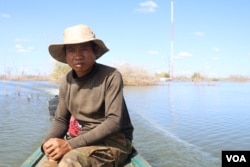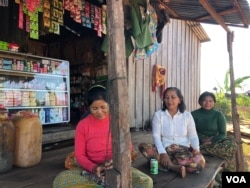Fut Kheun carefully steers his wooden longboat among the treetops and roofs that stick out above the water and then turns off his engine to pause.
This is all that remains visible of Srekor Village 1 where his family lived for generations on the banks of the Srepok River in northeast Cambodia until a large downstream dam turned the area into a huge reservoir in September 2017.
The gold-coloured spire and curving roof of a small wooden pagoda still juts above the water line like a monument to the lost village.
He quietly viewed the scene and said, “Our ancestors’ graves have been drowned in the flood.”
The Lao and Kreung indigenous minority villagers who lived here would honour their ancestors through ceremonies at the graves in accordance with their Buddhist-animist beliefs, and they would worship at the pagoda.
Fut Kheun, 39, said his and other families were deeply affected by the loss of the spiritual site, and their homes, farms and fishing livelihoods.
“I want to live here where we are content,” he told a visiting VOA reporter. “I don’t want to leave and betray my ancestors’ spirits; they are submerged under 4- or 5-meter-deep water.”
His family is among some 60 families from Srekor 1 Village who have refused the government’s order to accept a compensation package and housing at several remote resettlement sites.
About 800 other families - all belonging to various hill tribes from four villages near the Srepok and Sesan Rivers in Stung Treng Province - have reluctantly accepted the offer after years of protesting in vain against the construction of the mostly Chinese-funded, 400-megawatt Lower Sesan 2 Dam.
‘I will absolutely not go to the new site’
The holdout families have set up makeshift houses in a community forest on higher ground about 1 kilometer away from Srekor 1, where they can still move around in their boats and be close to their former village.
“I am not happy with the compensation offer and the important thing is that I want to protect my old village,” said Fut Kheun. “I will absolutely not go to a new site, I suggest they build a new village for us” in the community forest area.
The families are struggling to get by here, living off newly planted crops and forest products, while they lack government services such as education or health care. Living conditions are difficult and villagers say illness is common; some residents have even died since they moved.
“The ancestors are submerged that is what is making us sick. There are no more spirits from our parents and ancestors here [to protect us],” Fut Kheun’s 85-year-old father, Noy Fut, said during an interview at the site.
Nat Sota, 65, said she planned to stay put here as it was better than the resettlement site because it has drinking water and because she planted some crops, though she worried about the lack of education for her grandchildren.
Asked about the government’s refusal to acknowledge the holdout families, she said, “I am not angry with the government project since it is for the country’s development. I don’t protest against them. But I just ask for land for rice, and a farm and house here.”
Government pushes through dam
Local and international activist groups have long supported the villagers in their attempts to resist the project and gain better compensation, but these efforts were met by severe government pressure and sometimes arrests.
Activists also warned of a heavy environmental and socio-economic impact beyond the 33,000-hectare reservoir, as the dam at the confluence of the Sesan and Srepok Rivers will block fish migration from the Mekong River.
This could cut fish stocks with 9.3 percent across the Mekong Basin where millions of people rely on fishing, according to a study by the Proceedings of the National Academy of Sciences in the U.S.
Prime Minister Hun Sen and his government have downplayed such impacts and approved the $816-million project. It was built by a joint venture comprising Royal Group Co. Ltd. of Cambodian tycoon Kith Meng, Electricity of Vietnam, and China’s state-owned Hydrolancang International Energy Co. Ltd., the latter owning the project’s majority share.
Victor Jona, a spokesman of the Ministry of Mines and Energy’s department of energy, said the dam went ahead as it is important to Cambodia’s energy masterplan. This aims to increase domestic supply far above the current capacity of 2,500 Mw and provide a 100-percent electrification rate nationwide by 2020, up from the current 87 percent in rural areas.
Jona said all eight turbines of the dam were now running and energy production was “going well.” He added that “dam construction on the Mekong is also a consideration” to further raise power supply.
The tentative plan for the massive Sambor Dam in Kratie Province is highly controversial and a leaked government-commissioned study has warned of a devastating impact on the Mekong’s fisheries and ecosystem.
Jona said the hill tribe villagers simply had to make way for development and are taken care of at the relocation site. He suggested that the number of families refusing compensation was dropping and they should just settle for the government’s offer.
“[Only] at the beginning life is a bit difficult for villagers,” he said, when asked about the resettlement site conditions.
Resettlement site ‘not suitable’ to live
Villagers who accepted the offer, however, described resettlement conditions as inadequate and government support lacking. The area has few livelihood opportunities and villagers are cut off from the rivers that were the region’s transport ways and provided fish and other resources.
Vann Hong, a 50-year-old Lao minority villager from Srekor 1, said his compensation offer included a simple wooden house on a 20-by-50 meter plot, $4,200 for loss of crops, and about 5 hectares of farmland on which he had planted cashew nut trees.
Some 15 months after the relocation, however, authorities have still not provided basic services. The schools lacked teachers, while a constructed water reservoir was often dry, leaving residents to pay for drinking water delivery from outside.
“I have to buy water and spend around 120,000 Riels [$30] to 150,000 Riels [$37.5] a month,” Vann Hong said, adding that this was a significant expense as his only cash income came from sawing wood.
Tem Sophoan, a teacher at Sre Sronok Primary School at the site, said, “We have one class that has around 70 students… Normally in schools there are maximum 30 students per class.” He added that the secondary school building stood empty as it had no teachers at all.
Vann Hong lamented his plight, but said he felt powerful. “It is not suitable [to live] here but how can I protest more? If I had a choice, I would go back to my old village,” he said. “I have prayed and asked my ancestors to come to stay with us at the new village.”













